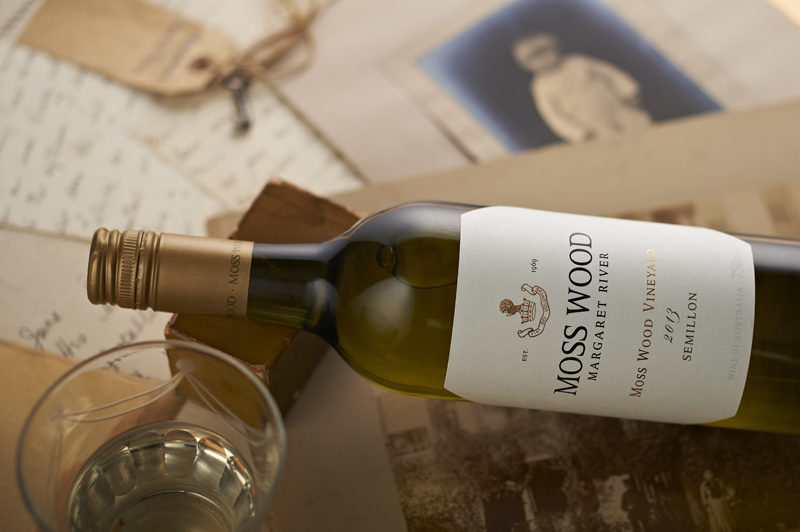Moss Wood Newsletter EarlySpring News Issue #83, September 2013
Moss Wood 2013 Semillon
Moss Wood 2010 Pinot Noir
Moss Wood Ribbon Vale Vineyard
2011 Cabernet Sauvignon Merlot
and Merlot
Moss Wood 2013 Semillon
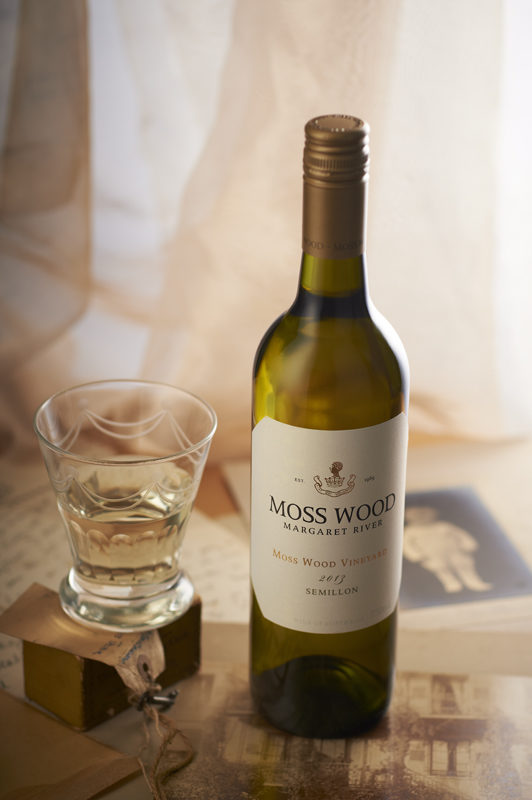
Vintage Notes
Let’s begin by saying it’s good to be back. Readers may have noted there was no 2012 Moss Wood Semillon and we are sad to admit this is the first time we haven’t released this wine since the original vintage in 1977. We must also admit last year’s wine was not sold because it simply wasn’t good enough. We have a proud, 36 year history of making high quality Semillon and we could not risk our reputation by selling a wine that did not meet the highest standard.
Having got that out of the way, we are also pleased to note that our comeback wine is from a particularly good year. The dream run for quality continued but unfortunately not for quantity. Initially our spring weather was good and flowering conditions were excellent.
Regular rain without damaging winds had kept the vines growing nicely. Flowering commenced in the first week of November and the next 2 weeks were delightful, with daily temperatures in the low to mid 20’s, apart from the 21st, when the mercury peaked at a beach-going 29°C.
Unfortunately, it was too good to be true. A strong weather system arrived on the 27th November and continued to batter us for the next 4 days, including a serious hailstorm on the 29th. Since the weather had been so good during the preceding 2 weeks, the Semillon had finished flowering and this may have been a blessing. Had the recently opened flowers been subjected to the full fury of the storm, our yield losses may have been even worse. Regardless, our yields took a big hit with the Old Block eventually producing 5.61 tonnes per hectare, down by 48% compared to its average of 10.7. The School Fees block yielded 10.1 tonnes per hectare, down 20% on its long term average of 12.65.
We suspect that damage in the latter was limited by virtue of its more sheltered location, although the physical appearance at the time didn’t really suggest this.
The last time we had an event like this was December 1996 and its impact was slightly less serious. Old Block Semillon yield in 1997 was 9.08 tonnes per hectare, 15% down on the long term average. The earlier storm was no less severe but came from the southwest, as opposed to the northwest in 2012, meaning the Semillon was much more exposed last year.
Once this problem was behind us, we proceeded to have a much more normal year. The birds began to show their usual interest and so nets were applied toward the end of January and we avoided any damage. Our fungicide spray program was successful and we had no disease issues and as we arrived at the beginning of February we settled into masterly inactivity while we waited for the fruit to ripen.
Mother Nature certainly did her bit. January was warm but not too hot and the vines made steady, if somewhat slow progress with ripening. We had only 11 hours above 33° C. These very pleasant conditions continued until 10th February when temperatures began to climb and over the next four days they climbed into the mid to high thirties. We had our warmest summer day on the 12th, when the mercury topped out at 39.5°.
This hurried the Semillon along and we picked it on 19th February, almost three weeks ahead of its average harvest date of 11th March. Ripeness was 12.7° Baume, almost exactly on the average of 12.6°.
No doubt the warm conditions and small crop brought the harvest date forward.
Production Notes
Median Harvest Dates and Ripeness:
19th February, 2013; 12.7° Baume
The fruit was hand harvested then de-stemmed, crushed and pressed. The free run juice was settled for 48 hours and then the clear juice was racked in preparation for fermentation.
To promote complexity, 2% of the volume was taken as
fluffy solids from the settling lees. Pure yeast culture was then added and fermentation proceeded at around 17° C for 13 days. The pressings were prepared separately and were fined to reduce the tannin concentration and settled for 5 days. Once clarified, the
clear juice was racked, seeded and fermentation proceeded at 18° C for 27 days. The ferment was typically slower and is a product of the fining treatments we applied to improve the mouth feel of the final wine.
After a week of settling on their gross lees, the two components were racked and blended to produce the final wine.
Once the blend was completed we carried out fining trials with a variety of agents. In the end we concluded there was a slight improvement of the tannin balance using isinglass and so the whole batch was treated.
The other treatment we use as a matter of course is bentonite, to ensure the wine is heat stable. Readers may be interested to know all wine contains naturally occurring protein which can precipitate in the bottle. There are a variety of reasons why this may occur but the primary one is excess heat. If a wine warms up, something that is possible during transport, a fine haze may develop which is the aforementioned protein dropping out of the solution. This is entirely natural and not in the least bit harmful to consumers but it does diminish the appearance of the wine, especially with white wines, which people expect to be bright and clear in the glass. Hence, all our white wines are treated to minimise the chance of this happening. Our reds, on the other hand, are not. Consumers are far more accepting of a “crust” in these wines. After fining the Semillon was sterile filtered and was bottled on 20th May, 2013.
Tasting Notes
Colour:
Medium straw colour, with green tints; bright condition.
Nose:
Classic young Semillon – fresh, scented fruit aromas of lemon rind, quince, apple and fig.
Palate:
Presents a generous, yet fresh and crisp combination of apple, grapefruit and fig flavours across the middle palate and finishes with a honey-like sweetness, over just a touch of astringency at the back. There is good length and smooth texture.
Cellaring:
Although Semillon is noted for its ability to cellar for the very long term, this wine offers enjoyable early drinking with its generous fruit flavours and freshness. However, the structure of the wine, with the crisp acidity and the presence of some tannin on the finish, make it ideal for cellaring. Over the next 5 years it will begin to evolve and show the first hints of classic Semillon bottle bouquet of butter, caramel, lanolin and toast. We expect it to reach its peak between 15 and 20 years of age and in good cellars, to continue to age well for at least a further 10 years.
Moss Wood 2010 Pinot Noir
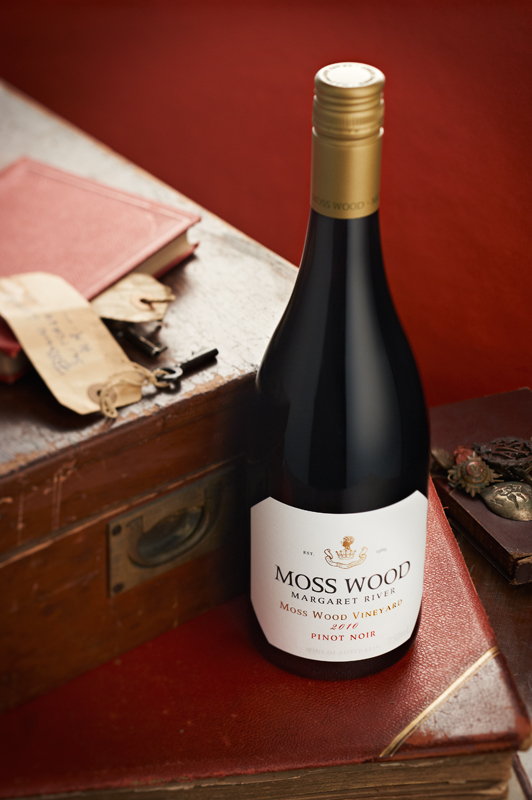
Vintage Notes
As we look back at the 2010 vintage, it’s hard not to be nostalgic. There haven’t been many better years than this and it is gradually becoming recognised as a Margaret River classic. Like others of the
same ilk, 1980, 1985, 1990, 1995 1996, 2001 and 2005, it was equally good for whites and reds. This reflects all the positives of the growing season. Not only did we get good rainfall, it came during periods when it did least harm. There was consistent warmth but very little extreme heat and so the vines ripened steadily and retained bright and complex fruit aromas.
With so many things in its favour, it comes as no surprise that crops were above average as well. This is not a concern with a variety like Cabernet Sauvignon which, in our view, makes some of its best wine in these years, with better tannin balance, in particular. On the other hand, Pinot Noir is more sensitive to high yield and can produce wines with reduced concentration, resulting in lighter colour and softer tannin. In a variety where these characteristics are already “lighter” this may not be a good thing and requires careful attention to detail.
There are several techniques for managing yields but at Moss Wood, we have focused mainly on two – bunch thinning and “saignee”, which is the French term for draining juice off the skins to improve colour and flavour.
The both techniques involve a combination of science and guess work. With the former, we sample the vineyard to estimate the number of bunches each vine has and then use our historical data to estimate yield based on the likely range of bunch weights. If the potential yield is deemed too high, then we carry out a “green harvest” by going through the vineyard and dropping a calculated number of bunches from each vine. This has to be done at a point in the season where the vines won’t respond by increasing the size of the berries. Overall, the lack of accuracy means this technique is something of a blunt object – a bit like using a large sledge hammer to drive in a tack. This being the case, we combine it with the second technique of juice removal.
Once the fruit is picked and sitting in the tanks, we know exactly what our quantities are and can work out with some precision what volume of juice we would prefer.
We know from our history what the best ratio of skins to juice is and we attempt to match that. It would be foolish to think of this as scientific, because we can’t know beforehand what the actual levels of all the key components are and it follows that we can only guess the likely impact of increased concentration will have.
It could all be viewed as part of the wonderfully artistic side of winemaking and one thing’s for sure, in the lower crop years, whether naturally occurring, or by man-made technique, we have always made Pinot Noir wines of greater depth and intensity.
If we contrast the 1981 and 2000 vintages, this is held in stark relief. The ’81 was a very small crop (3.48 tonnes per hectare), and had intense fruit aromas and flavours and is still the best wine we’ve made. The 2000 was a very big crop (11.42 tonnes per hectare) and has bright fruit notes and reasonable length but nothing like the overall depth of the earlier year.
Returning to the 2010 vintage, we calculated a yield estimate that suggested the vineyard would yield between 8 and 9 tonnes per hectare. With a small green harvest and then juice removal we brought it back to an equivalent of 6.8 tonnes per hectare, slightly above the long term average of 6.5 tonnes. As we said, this is not an exact science but we got close.
The season was almost exactly average in length, with a ripening time from flowering to harvest of 104 days, slightly behind the average of 100 days, while the median harvest date was 22nd February, 2 days later than the average of February 24th. We’ve saved the best of the climate-related bits for last. The really positive part of the growing season was the temperature. Both January and February were mild, with mean temperature of 20.23° C and 20.79° C, respectively, but the best number of all was the overall lack of extreme heat - the Pinot Noir accrued only 24 hours above 33° C. While this would not be good for Cabernet Sauvignon, it is ideal for wines with more delicate fruit aromas like the whites and, of course, Pinot Noir and hence is a major part of the explanation for 2010 being such a good vintage, across the board.
It is also nice to report we had no disease outbreaks in the vineyard and had a good Redgum flowering and so the birds used the blossom as a food source, not our grapes.
Production Notes
Median Harvest Dates and Ripeness:
22nd February, 2010; 13.3° Baume
As is always the case with Moss Wood wines, the fruit was hand-picked and delivered to the winery where it was de-stemmed into small, open fermenters. The must was cooled to 10°C and allowed to macerate for 2 days, then it was seeded with a pure yeast culture for primary fermentation.
Ferments progressed at a maximum temperature of 30°C and were hand plunged 3 times per day, for extraction of colour and flavour. Each batch was tasted twice per day, to monitor tannin balance and eventually the decision was made to press each batch after 2 weeks on the skins.
Once pressed, the wine settled in tank and was inoculated for the malolactic fermentation which went through over 2 weeks. When completed, each batch was racked and adjusted for acidity and sulphur dioxide levels and then put into oak.
All barrels were French and 20% were new. The wine stayed in barrel until October 2011 when it was racked and blended. Fining trials were then carried out but none improved the wine so it was left unfined. It was then sterile filtered and bottled on 19th December, 2011.
Tasting Notes
Colour:
Bright condition; medium ruby hue.
Nose:
A bright combination of strawberries, strawberry jam, cherry and spice, enhanced by an ethereal rose-like lift. It is also complex, with soft oak, earthy and tarry notes.
Palate:
The feel is rich and bright; medium to full body combined with bright strawberry and cherry flavours and then a long finish of earthy notes and well balanced tannins.
Cellaring:
Once again the Pinot Noir provides a dilemma. There is great drinkability in this young wine with its excellent balance and fruit depth, but it is this depth and complexity that give it the style and structure to go the distance.
It will take at least 10 years to build its bottle bouquet, so it has a recommended cellaring time of 15 years. Beyond that, it should cellar well for at least a further 10 years.
Moss Wood Ribbon Vale 2011 Cabernet Sauvignon Merlot and Merlot
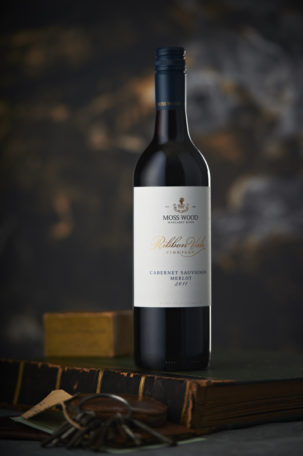
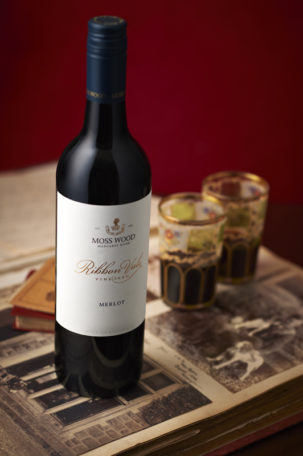
Vintage Notes
There is a strong theme running through the 2011 vintage – consistent warmth. Our January temperatures were typical, if not slightly on the higher side, with an average of 20.97°C but things
really got going in February. The mean monthly temp was 23.76°C, making it the warmest February since our weather station was installed in 1998. To put that into perspective, the average temperature for that month is 21.21°C. Given a variation of
0.5° will produce a perceivable effect on fruit aromas, this difference of 2.55° was significant.
Examining the temperature record further, we see that the vines received 49 hours above 33°C during February. Cabernet Sauvignon would only need that much warmth across the entire growing season to display ripe fruit characters, so to have received that much in one month is best described as an abundance of warmth.
Vines are fairly hardy plants and hot weather, per se, is not a problem, as long as they’re not subjected to extreme temperatures and this is where 2011 really scores. Despite a warmer than average February, our hottest day was 39.7°C and apart from that, the maxima exceeded 33°C on 10 days.
March was also warm, with an average temperature of 21.36°C, 1.54° above the average. However, the maximuma were more typical of Autumn and we only received 7 hours above 33°C.
To summarise the impact of all this is relatively simple. We experienced consistent ripening through the season and so sugar accumulation by the vines was steady and was always going to comfortably achieve “normal” levels. Furthermore, the tendency toward higher temperatures in February, without excess extreme heat, has promoted typically ripe fruit characters and tannins giving all the wines generous mouth feel, not unlike the 2007’s but with more finesse.
As an aside, we don’t have the data for 2007 because the temperature probe wasn’t operating properly. What we assume from the harvest dates and taste of the wines is that 2011 was a little cooler.
Mother Nature didn’t give us too many surprises, although things didn’t go entirely our way. Cabernet Franc gave a yield of 6.27 tonnes per hectare, down by 30% and Merlot cropped at 7.56 tonnes per hectare, down 13%. On the other hand, Cabernet Sauvignon, at 7.39 tonnes per hectare, was down only 4%. A quick look at our rainfall record tells us why.
Cabernet Franc started flowering on 1st November and was virtually right in the middle of the process when, on 8th, 9th and 10th November, we had a good dump of rain – 32 millimetres fell and temperatures dropped down to 6°C overnight. No surprise then that its bunch weights fell by 5%. The fact that the yield loss was greater than this would suggest bunch numbers and actual berry weights being lower than average but we don’t know for sure. Readers may be amused to learn that not even Keith is a big enough nerd to separate berries from the bunch and count and
weight them.
The other two varieties show just what a difference a day (or two) makes. Merlot started flowering a few days later on 4th November, so it wasn’t quite as advanced when the rain came, resulting in a much smaller yield loss. Cabernet Sauvignon started after the event was behind us and it was virtually unaffected.
Despite the rain interruption we kept our spray program on track and disease was not a problem and neither were the birds.
With all the warm weather and low to average yields, the vineyard sailed quickly on to an early harvest. Merlot came off first on 3rd March, 2 weeks ahead of average, followed by Cabernet Franc on 10th March, 6 days early and then Cabernet Sauvignon was picked on 16th March, also 2 weeks early. The Merlot was picked at its average ripeness of 13.1° Baume, Cabernet Franc at 13.2° Baume, slightly less ripe than the 13.4o average and Cabernet Sauvignon came off right on the average at 13.6°.
Production Notes
Median Harvest Dates and Ripeness:
Cabernet Sauvignon – 13.6° Baume; 16th March, 2011
Merlot – 13.1° Baume; 3rd March, 2011
Cabernet Franc – 13.2° Baume; 10th March, 2011
All three varieties were handpicked and then transported to the winery for processing. The fruit was de-stemmed into fermenters, seeded for primary fermentation with a pure yeast culture and fermentation proceeded at temperatures up to 28° C. Each batch was plunged 3 times per day and tasted twice per day to monitor the levels of extraction. One of the interesting points about the 2011 vintage is that the wines developed good tannin balance with relatively short skin contact time. The Cabernet Franc was pressed after 9 days, the Merlot after 12 days and the Cabernet Sauvignon after 15 days.
After pressing the wines underwent malolactic fermentation in tanks and were then racked into barrels during May and June 2011. All the oak was French and 20% were new. In February 2012 all batches were racked to tank and after extensive tasting trials, the final blends were assembled. The Cabernet Sauvignon Merlot wine proved to be something of a departure from tradition, with the final wine being made up of 55% Cabernet Sauvignon, 42% Merlot and 3% Cabernet Franc. The smaller crops in the latter two, but especially the Merlot, seemed to enhance their concentration and depth and made much bigger contributions to the wine than would normally be the case.
The Merlot wine was more closely aligned with the past, the final blend being 93% Merlot and 7% Cabernet Franc. In this blend the concentration of the Cabernet Franc tannins really added significant palate weight. The two blended wines were returned to oak for a further 12 months.
In February 2013 they were racked from barrel and fining trials were carried out. Neither wine was improved by fining, so no additions were made. This is further testament to the balance and ripeness of the tannins in 2011. Both wines were sterile filtered and bottled on 8th April, 2013.
Moss Wood Ribbon Vale 2011 Cabernet Sauvignon Merlot
Tasting Notes
Colour:
Bright condition; deep brick red hue.
Nose:
A deep and complex nose combining rich red currant, tobacco, earth, tar and cedar; complex, with great power.
Palate:
Full bodied, great concentration of red and dark fruit; complexity from tar and aniseed notes. The tannins are ripe and firm but do not impinge on the texture, giving very smooth mouth feel and length.
Cellaring:
With the soft, ripe tannins of 2011, the wine is enjoyable now but has everything required for a long life in the cellar. It shares the style and presence of 2007, 2003 and 1983 and so we expect it will take until 2026 for the wine to develop the full range of its aged characters, like smoke, wax and leather and to show some softening of the tannin.
Moss Wood Ribbon Vale 2011 Merlot
Tasting Notes
Colour:
Bright condition; deep brick red hue.
Nose:
Complex nose consisting of fruit aromas of cherry, blackberry, mulberry and rhubarb combined with tar and earth. Soft oak notes in the background, combined with leathery, earthy notes.
Palate:
The impact of the Cabernet Franc is interesting here. The dominant feature is the generous Merlot blackberry-like fruit but sitting beside it a bright cherry-like lift. The tannins have Merlot’s typical mid-palate firmness but the chalky concentration of the Cabernet Franc completes the wine and adds to the length.
Cellaring:
In many respects, Merlot is like Pinot Noir. It has a generosity of fruit as a young wine that encourages consumers to drink the wine while young and fair enough, because the 2011 provides lots of that. However, the ripe and concentrated tannins are an ideal platform for cellaring and this wine should mimic the very great years like 1996 and develop into a soft and complex old wine. It will need another 15 years aging to do this but should continue on for at least another 10 years after that.
Order
OUR WINES:
Contact
MOSS WOOD:
Location: 926 Metricup Road, Wilyabrup WA
Postal: PO Box 225, Cowaramup WA 6284
Phone: +61 8 9755 6266
Fax: +61 8 9755 6303
Follow us on
SOCIAL MEDIA:

